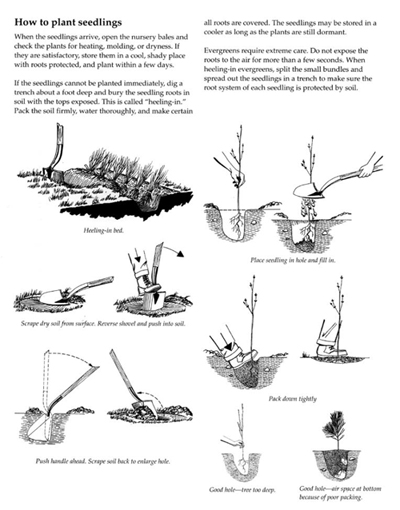 Purdue University - Extension - Forestry and Natural Resources
Purdue University - Extension - Forestry and Natural Resources
Got Nature? Blog
 As the snow finally melts, we are approaching the prime time for planting bare-root trees and shrubs in Indiana. Planting bare-root seedlings is a proven, cost-efficient method to establish trees and shrubs on your property for a variety of purposes, as long as some basic steps are followed.
As the snow finally melts, we are approaching the prime time for planting bare-root trees and shrubs in Indiana. Planting bare-root seedlings is a proven, cost-efficient method to establish trees and shrubs on your property for a variety of purposes, as long as some basic steps are followed.
Prior to planting, prepare your site by eliminating competing vegetation where the seedlings will be planted. This can be done with tillage or herbicides. Areas with heavy sod or perennial weed growth are very difficult sites for small seedlings to survive and thrive. Clear all the competing vegetation in the planting area or create circles or bands two to three feet wide where the seedlings can grow. Be sure your site is suited to the species you want to plant. Soil survey and tree planting information from the USDA Natural Resources Conservation Service is available for every county in the state, either at NRCS offices or on the Web Soil Survey website: http://websoilsurvey.sc.egov.usda.gov.
When you receive your seedlings, keep them cool and moist until you can plant them. Plant them as soon as possible since the best place to store a seedling is in the soil! If you can’t plant them within a few days of their arrival, you can dig a trench and “heel in” the seedlings by planting them very close together and covering the roots with soil and/or moist mulch. This is still a short-term storage solution. You want to have your trees planted in their final locations before buds start to open.
When planting, keep seedlings stored in the shade, and roots should be kept moist until placed in the ground. A five gallon bucket with wet peat or sphagnum moss will work just fine for transporting seedlings to their planting locations. You can use several tools for planting, including shovels and commercial tree planting bars. The critical factors are planting the seedling at the correct depth and getting the root system in the ground such that it has good contact with the soil and is ready to grow. Seedlings should be planted with the root collar at or slightly below ground line. The root collar is where the stem changes to the root and is recognized by a color and texture change on the seedling stem. Be sure the soil is firmed around the seedling to close any air pockets that can dry out roots. Get your planting done as early in the spring as you can to take advantage of spring rains and a longer growing season for the seedling.
There are many more considerations for planning and implementing a successful tree planting that you can review in extension publications. See resources below for publications and videos.
To view the large photo used in this posting, visit How To Plant Seedlings.
Resources:
Planting Forest Trees and Shrubs in Indiana, The Education Store, Purdue Extension’s resource center
Native Trees of the Midwest, Purdue University Press
Shrubs and Woody Vines of Indiana and the Midwest, Purdue University Press
Investing in Indiana Woodlands, The Education Store
Forest Improvement Handbook, The Education Store
ID That Tree, Purdue Extension-Forestry & Natural Resources (FNR) YouTube playlist
Woodland Stewardship for Landowners Purdue Extension – FNR Extension YouTube Playlist
Woodland Management Moment, Purdue Extension-FNR YouTube playlist
Conservation Tree Planting: Steps to Success, Purdue Extension – FNR Got Nature? Blog
Lenny Farlee, Extension Forester
Hardwood Tree Improvement and Regeneration Center
Forestry and Natural Resources, Purdue University

Recent Posts
- HTIRC Continues to Protect Our Hardwood Forests
Posted: April 18, 2025 in Forestry, Timber Marketing, Woodlands - Tips to Manage Storm-Damaged Trees, Purdue Landscape Report
Posted: April 17, 2025 in Forests and Street Trees, How To, Urban Forestry - Liz Jackson Receives IHLA’s President’s Award, Featured in ANR Newsletter
Posted: in Forestry, Timber Marketing, Wildlife, Wood Products/Manufacturing, Woodlands - A Woodland Management Moment: Bottomland Forests
Posted: in Forests and Street Trees, Urban Forestry, Wildlife, Woodland Management Moment, Woodlands - When is the Peak Migration For Hummingbirds and How Can You Attract Them?
Posted: April 4, 2025 in How To, Wildlife - Smooth Patch of Oak – Purdue Landscape Report
Posted: March 27, 2025 in Forests and Street Trees, Urban Forestry, Wildlife, Woodlands - Prepared for Insects Waking Up? – PLR
Posted: March 26, 2025 in Forestry, Invasive Insects, Urban Forestry, Wildlife - ID That Tree: Invasive Autumn Olive
Posted: March 24, 2025 in Forestry, Invasive Plant Species, Urban Forestry, Wildlife, Woodlands - PPDL’s 2024 Annual Report – Enhancing Plant Health
Posted: March 21, 2025 in Forestry, Invasive Insects, Invasive Plant Species, Plants, Wildlife - Rays Sharing Their Award Winning Forest – Oak Management Forestry Field Day
Posted: March 20, 2025 in Forestry, How To, Invasive Plant Species, Wildlife, Woodlands
Archives
Categories
- Alert
- Aquaculture/Fish
- Aquatic/Aquaculture Resources
- Ask the Expert
- Christmas Trees
- Community Development
- Disease
- Drought
- Forestry
- Forests and Street Trees
- Gardening
- Got Nature for Kids
- Great Lakes
- How To
- Invasive Animal Species
- Invasive Insects
- Invasive Plant Species
- Land Use
- Natural Resource Planning
- Nature of Teaching
- Plants
- Podcasts
- Ponds
- Publication
- Safety
- Spiders
- Timber Marketing
- Uncategorized
- Urban Forestry
- Webinar
- Wildlife
- Wood Products/Manufacturing
- Woodland Management Moment
- Woodlands